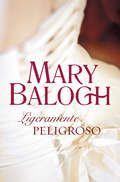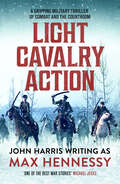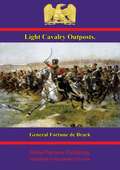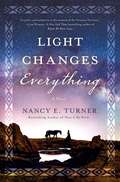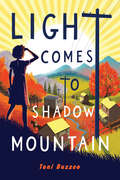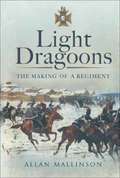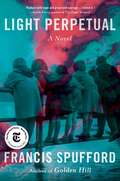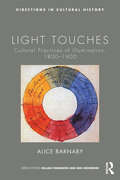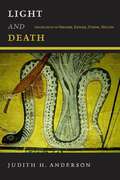- Table View
- List View
Ligeramente peligroso (Bedwyn #Volumen 6)
by Mary BaloghLa última entrega de la serie Bedwyn. Dos seres tan distintos que, sin duda, están condenados a enamorarse. Aunque de entrada, ella le ha rechazado... La llegada de Wulfric Bedwyn, duque de Bewcastle, a la fiesta campestre por excelencia de la temporada ha revolucionado a la alta sociedad londinense. Es uno de los hombres más ricos, poderosos e influyentes del reino; también el más altivo y distante. Pero en esta deslumbrante tarde de verano, mientras todas las miradas femeninas convergen en el apuesto y arrogante duque, él solo parece tener ojos para la única mujer que de ninguna manera querría llamar su atención. Christine Derrick es inmune a su título y su posición. Lo desconcierta y lo exaspera con su vitalidad y sus francas maneras. Es absolutamente inadecuada para él. Pero a su lado, por primera vez en su vida, Wulfric siente que ese muro de frialdad y reserva que ha levantado entre él y el mundo se empieza a resquebrajar.
Ligeramente peligroso (Bedwyn #Volumen 6)
by Mary BaloghLa última entrega de la serie Bedwyn. Dos seres tan distintos que, sin duda, están condenados a enamorarse. Aunque de entrada, ella le ha rechazado... La llegada de Wulfric Bedwyn, duque de Bewcastle, a la fiesta campestre por excelencia de la temporada ha revolucionado a la alta sociedad londinense. Es uno de los hombres más ricos, poderosos e influyentes del reino; también el más altivo y distante. Pero en esta deslumbrante tarde de verano, mientras todas las miradas femeninas convergen en el apuesto y arrogante duque, él solo parece tener ojos para la única mujer que de ninguna manera querría llamar su atención. Christine Derrick es inmune a su título y su posición. Lo desconcierta y lo exaspera con su vitalidad y sus francas maneras. Es absolutamente inadecuada para él. Pero a su lado, por primera vez en su vida, Wulfric siente que ese muro de frialdad y reserva que ha levantado entre él y el mundo se empieza a resquebrajar.
Ligeramente perverso (Bedwyn #Volumen 2)
by Mary BaloghSegunda entrega de la serie Bedwyn ¿Podrán Judith y Rannulf ocultar al mundo su secreto ligeramente perverso? No es el heroico salteador de caminos con el que estaba soñando momentos antes del accidente. Sin embargo, algo en los ojos risueños y provocadores del jinete que se ha acercado a socorrer al coche de postas despierta en Judith Law un anhelo de aventura, por fugaz que sea. Nada puede apartarla del tedioso y gris futuro que recientemente se ha abierto ante ella; solo podrá eludirlo un instante... que no va a dejar escapar. También desde el primer momento, Rannulf Bedwyn se ha sentido atraído por esta joven que se ha presentado como Claire Campbell, una actriz de teatro. En cambio él no le ha revelado su auténtico nombre y posición, que solo conllevan obligaciones y deberes en los que ahora no querría pensar. Como el de casarse sin amor. Durante dos días, en que el tiempo parece detenerse, ambos juegan a engañar a sus auténticos destinos, hasta que la realidad se impone a las fantasías. Ninguno conoce la verdadera identidad del otro. No imaginan que jamás vuelvan a encontrarse. Pero cuando el destino les una de nuevo, tendrán que ocultar ante el mundo su secreto ligeramente perverso. Reseña:«Ligeramente perverso, la segunda entrega de la saga de los Bedwyn, es una historia intrigante, absolutamente cautivadora, de amor, pasión, deber y honor.»Romance Reviews Today
Ligeramente perverso (Bedwyn #Volumen 2)
by Mary BaloghSegunda entrega de la serie Bedwyn ¿Podrán Judith y Rannulf ocultar al mundo su secreto ligeramente perverso? No es el heroico salteador de caminos con el que estaba soñando momentos antes del accidente. Sin embargo, algo en los ojos risueños y provocadores del jinete que se ha acercado a socorrer al coche de postas despierta en Judith Law un anhelo de aventura, por fugaz que sea. Nada puede apartarla del tedioso y gris futuro que recientemente se ha abierto ante ella; solo podrá eludirlo un instante... que no va a dejar escapar. También desde el primer momento, Rannulf Bedwyn se ha sentido atraído por esta joven que se ha presentado como Claire Campbell, una actriz de teatro. En cambio él no le ha revelado su auténtico nombre y posición, que solo conllevan obligaciones y deberes en los que ahora no querría pensar. Como el de casarse sin amor. Durante dos días, en que el tiempo parece detenerse, ambos juegan a engañar a sus auténticos destinos, hasta que la realidad se impone a las fantasías. Ninguno conoce la verdadera identidad del otro. No imaginan que jamás vuelvan a encontrarse. Pero cuando el destino les una de nuevo, tendrán que ocultar ante el mundo su secreto ligeramente perverso. Reseña:«Ligeramente perverso, la segunda entrega de la saga de los Bedwyn, es una historia intrigante, absolutamente cautivadora, de amor, pasión, deber y honor.»Romance Reviews Today
Ligeramente seductor (Bedwyn #Volumen 4)
by Mary BaloghCuarta entrega de la serie Bedwyn Escándalos, intrigas, venganzas y una bella historia de amor en la nueva entrega de esta serie ambientada en la Regencia. Gran parte de la sociedad británica se ha congregado en Bruselas en vísperas de la batalla de Waterloo, entre ellos Morgan Bedwyn y Gervase Ashford. Gervase ha vivido los últimos años en el exilio a causa de una falsa acusación vertida por Wulf Bedwyn, el hermano de Morgan. Ahora, seduciendo a Morgan, prevé la oportunidad de vengarse a través de ella. Pero, a pesar de sus planes iniciales, Gervase se enamora de Morgan. Para evitar escándalos, le propone matrimonio, sin considerar que Wulf se negará en redondo a esta unión y que Morgan, por lealtad, jamás aceptaría.
Ligeramente seductor (Bedwyn #Volumen 4)
by Mary BaloghCuarta entrega de la serie Bedwyn Escándalos, intrigas, venganzas y una bella historia de amor en la nueva entrega de esta serie ambientada en la Regencia. Gran parte de la sociedad británica se ha congregado en Bruselas en vísperas de la batalla de Waterloo, entre ellos Morgan Bedwyn y Gervase Ashford. Gervase ha vivido los últimos años en el exilio a causa de una falsa acusación vertida por Wulf Bedwyn, el hermano de Morgan. Ahora, seduciendo a Morgan, prevé la oportunidad de vengarse a través de ella. Pero, a pesar de sus planes iniciales, Gervase se enamora de Morgan. Para evitar escándalos, le propone matrimonio, sin considerar que Wulf se negará en redondo a esta unión y que Morgan, por lealtad, jamás aceptaría.
Light & Shoot 50 Fashion Photos: 50 Fashion Photos
by Chris GatcumFashion photography has always called for the maximum creative variety, with a constant pressure for photographers to produce fresh, exciting work with complicated, considered lighting and location design. Whether you're starting out or have many years of experience, this book is an accessible and varied way to explore the genre and pick up new ideas.Each of the 50 fashion photographs is accompanied by complete details on how it was achieved with insights from the photographer, alongside a detailed 3D lighting diagram showing where all the equipment and props were placed. Armed with all this detail, it's easy to see how photos were made, learn how to use equipment, and develop as a photographer.There is also an introduction to camera and lighting equipment, and a complete glossary of terminology.
Light And Shade In War [Illustrated Edition]
by Noel Ross Captain Malcolm RossTwo Kiwis recount their experiences of the Front at Gallipoli and France during the First World War. Included are a number of their own photographs."THE authors of this book, father and son, have seen much of the Light and Shade of War during the past two years, the one as a War Correspondent in Egypt, Turkey and France, the other as a soldier, and, afterwards, as one of the staff of The Times."The day for writing the histories of our different campaigns is not yet. For the purposes of history delay is necessary, even though the gain in perspective may mean loss in colour. But there is a legitimate desire for the intimate and immediate impressions of the time, written down amid the ever-shifting scenes of the War itself. Such impressions will have some value now, and perhaps also in after years.Most of these sketches were written whilst the scenes and incidents they depict were fresh in the mind; some under fire. The proofs were corrected on the battlefield of the Somme in a tent over which British and German shells were passing at the time. While due allowance will be made for shortcomings owing to the circumstances under which the book was produced, the authors hope that no apology will be needed for presenting such pictures of the Light and Shade of War to the English-speaking World."
Light Cavalry Action: A gripping military thriller of combat and the courtroom (By Air, By Land, By Sea Collection)
by Max HennessyA military hero? Or a traitor to his comrades and his country? A gripping thriller full of suspense and intrigue, from master author Max Hennessy.When, in 1939, a letter cast doubts on the military reputation of a man likely to become Commander-in-Chief of the British Expeditionary Force if war with Germany should be declared, he had no alternative but to bring the matter to court.The case took the judge, the jury and a fascinated public back to a day in the winter of 1919 when British troops, in action against Bolshevik forces in South Russia, made the last charge of British horsed cavalry. Their commander wasLieutenantGeneral Henry Prideaux: for this, ‘the Balaclava of the Russian Civil War’, he won the D.S.O. and made his name.But justifiably? ‘The truth,’ one of his subordinates in the action had written, 'is that before – and after – the action at Dankoi, when it came to leading and giving orders, Colonel Prideaux was noticeably not among those present.’A scintillating story of deceit, conflict and the final days of British cavalry might, this is Max Hennessy at his very best, perfect for fans of Alistair MacLean, John Grisham and A Few Good Men.
Light Cavalry Outposts
by General Fortune de Brack Colonel L A Hale R. E. HaleGeneral De Brack served Napoleon and France for many years as a light cavalryman during the wars that raged for over a decade. He served under some of the most able and dashing of officers, including the legendary Lasalle and the celebrated Pajol. During this time, the skills and instincts of outpost duty were engraved on his mind, time-taught instincts long forgotten by the army in peace time. In his older age he was approached by the officers of his regiment to recount his advice, lessons and memoirs so that the invaluable experience could be passed on. In his book, Light Cavalry Outposts, General De Brack dispenses his maxims for service in the light cavalry interspersed with memories of his service under the eagles of Napoleon. Author -- General Fortune de Brack (1794-1854)Translator -- Colonel L A Hale, R.E. (d. 10.1914)Text taken, whole and complete, from the fourth edition published in London, W. Mitchell and Co, 1876.Original Page Count - xxii, 308 p.Illustrations -- 3 maps and plans.
Light Changes Everything: A Novel
by Nancy E. Turner“I adored stepping into to the world of the Prines through tough-as-rawhide Mary Pearl. Light Changes Everything is a novel as gritty and authentic as the women of the Arizona Territory. Nancy E. Turner brings the west and its people fully to life.” –Lisa Wingate, #1 New York Times bestselling author of Before We Were Yours Bestselling author Nancy E. Turner returns to the world of Sarah Agnes Prine through the wide-eyes of her irrepressible young niece, Mary Pearl.It’s the summer of 1907 and the sun is scorching down on Mary Pearl in the Arizona Territory. Mary Pearl and her sister Esther take their minds off the heat by sneaking banned Jane Austen novels from Aunt Sarah Elliot’s lively bookshelf. Whispered read alouds preoccupy their nights, and reveries of getting hitched to their own Mr. Darcy à la Pride and Prejudice swirl through their day dreams. In walks old-fashioned old-money suitor Aubrey Hanna, here to whisk seventeen year old Mary Pearl off her feet with a forbidden kiss and hasty engagement. With the promise of high society outings and a rich estate, Aubrey’s lustful courtship quickly creates petty tension among the three generations of Prine women.As autumn approaches all too quickly, Mary Pearl’s Wheaton College acceptance counters quick marriage preparations. Days of travel by horse and by train carry her deep into a sophisticated new world of Northern girls’ schooling. Seeking friendship but finding foes, Mary Pearl not only learns how to write, read, and draw, but also how to act, dress, and be a woman. Light Changes Everything is the story of a resilient young feminist a century ahead of her time. Full of gumption and spirit, Mary Pearl’s evocative coming of age tale is destined to be the next American classic.
Light Comes to Shadow Mountain
by Toni BuzzeoCora Mae Tipton is determined to light up her Appalachian community in this historical fiction novel from an award-winning author and former librarian.It&’s 1937 and the government is pushing to bring electricity to the mountains of southeastern Kentucky. It&’s all Cora can think of; radios with news from around the world, machines that keep food cold, lightbulbs by which to read at night! Cora figures she can help spread the word by starting a school newspaper and convincing her neighbors to support the Rural Electrification Act.But resistance to change isn&’t easy to overcome, especially when it starts at home. Cora&’s mother is a fierce opponent of electrification. She argues that protecting the landscape of the holler—the trees, the streams, the land that provides for their way of life—is their responsibility. But Cora just can&’t let go of wanting more. Lyrical, literary, and deeply heartfelt, this debut novel from an award-winning author-librarian speaks to family, friendship, and loss through the spirited perspective of a girl eager for an electrified existence, but most of all, the light of her mother&’s love and acceptance.Back matter includes an Author&’s Note; further information on the Rural Electrification Act, the herbs and plants of Appalachia, the Pack Horse Library Project, and more; and a &“Quick Questions&” historical trivia section for readers.A Junior Library Guild Gold Standard Selection
Light Dragoons: The Making of a Regiment
by Allan MallinsonAlthough only formed in December 1992, The Light Dragoons look back to a history that began in the days of the first Jacobite rebellion. In 1922 a reduction in the Armys strength saw the amalgamation of four regiments of Hussars into the 13th/18th Hussars and the 15th/19th Hussars. Now they too have been amalgamated, with a name that reverts to the titles of the four original regiments in the eighteenth century. Allan Mallinson, the novelist and a former commanding officer of the 13th/18th Hussars, not only follows with admirable clarity and dexterity the fortunes of The Light Dragoons predecessors in this new edition, but describes the activities of the new regiment up to the minute. It is a crowded canvas which reflects much of the last two hundred and seventy years of British history. No campaign of significance has been fought in that time without the participation of one or more of the Regiments. Three, for instance, fought in the Peninsula, one in the Crimea and three in South Africa.In the twentieth century they gained fresh honours in both World Wars and, since 1945, have been fully involved in Britains withdrawal from Empire, the Cold War, United Nations peacekeeping and Iraq and Afghanistan.The new Postscript gives the reader a fine account of what wars in Bosnia and Iraq have involved for the Regiment and the men who serve in it and this updated history is a superb snapshot of life in war and peace for a British armoured reconnaissance regiment. Light Dragoons takes its place among the classics of this genre such as Sir Arthur Bryants Jackets of Green and Rudyard Kiplings account of the Irish Guards in the Great War.
Light History of Hot Air
by Peter DohertyNobel Prize-winner Peter Doherty's enthusiasm and curiosity about the world around him informs this atmospheric collection of stories on illumination, hot air and burning in all their guises. Written with great style and richly intimate with personal anecdotes, A Light History of Hot Air is concerned with the world and the simple beauty of science. Doherty shines a unique, tangential light of insight that reveals his subjects in new and unexpected ways. A childhood in Queensland awakens a boy's-own-adventure enthusiasm for trains and ships; further learning leads to admiration for such engineering marvels as the humble refrigerator and the steady march of progress that has brought us from tallow candles to electric lights. Featuring cameos from Albert Einstein, Samuel Pepys, Charles Dickens and Thomas the Tank Engine, among others, A Light History of Hot Air is an unmissable treat.
Light Horse
by Jean BouThe mounted soldier is one of the most evocative symbols in Australian military history. Now a celebrated part of Australia's army heritage, the role and very existence of mounted troops in modern warfare was being called into question at the time of its most crowning military moments. Light horse regiments, particularly those that served in South Africa, Palestine and the trenches of Gallipoli, played a vital role in Australia's early military campaigns. Based on extensive research from both Australia and Britain, this 2009 book is a comprehensive history of the Australian Light Horse in war and peace. Historian Jean Bou examines the place of the light horse in Australia's military history throughout its existence, from its antecedents in the middle of the nineteenth century, until the last regiment was disbanded in 1944.
Light It Up: The Marine Eye for Battle in the War for Iraq
by John PettegrewExamines the U.S. Marines’ visual culture of combat in the Iraq War.American military power in the War on Terror has increasingly depended on the capacity to see the enemy. The act of seeing—enhanced by electronic and digital technologies—has separated shooter from target, eliminating risk of bodily harm to the remote warrior, while YouTube videos eroticize pulling the trigger and video games blur the line between simulated play and fighting.Light It Up examines the visual culture of the early twenty-first century military. Focusing on the Marine Corps, which played a critical part in the invasion and occupation of Iraq, John Pettegrew argues that U.S. military force in the Iraq War was projected through an "optics of combat." Powerful military technology developed in the Iraq and Afghanistan wars has placed war in a new posthuman era.Pettegrew’s interviews with marines, as well as his analysis of first-person shooter videogames and combat footage, lead to startling insights into the militarization of popular digital culture. An essential study for readers interested in modern warfare, policy makers, and historians of technology, war, and visual and military culture.
Light One Candle: A Survivor's Tale from Lithuania to Jerusalem
by Solly GanorForty-seven years after he was found half-dead in the snow, following a death march from Dachau, Solly Ganor again came face to face with his rescuer Clarence Matsumura at a reunion of Holocaust survivors and their American liberators. That meeting proved a catharsis, enabling Ganor to confront for the first time the catalogue of horrors he experienced during the Second World War. Beginning in prewar Lithuania, Light One Candle tells of the ominous changes that took place once Hitler came to power in 1933, of Chiune Sugihara, the Japanese consul who wrote thousands of exit visas for Jews fleeing the Nazi onslaught, of the brutal conditions in the Kaunas ghetto where Ganor spent most of the war, and of Stutthoff and Dachau, the concentration camps he was shuttled to and from in the last, desperate days of the war. Unflinching in its depiction of evil but uplifting in its story of the survival of the human spirit, Light One Candle is a gripping memoir that waited fifty years to be told.
Light Perpetual (Hussite Trilogy #3)
by Andrzej SapkowskiFrom the globally bestselling author of The Witcher comes the final book in the rich historical epic, the Hussite trilogy. Join Reynevan—scoundrel, magician, possibly a fool—as he embarks on a last great adventure across the war-riddled landscape of 15th century Bohemia.After his adventures in The Tower of Fools and Warriors of God, Reynevan is on the run again, harried by enemies—some human, and some mystical—at every turn. These are cruel and dangerous times for a man such as Reynevan, and to survive, he must set aside his history as a peaceful healer and idealist and play the brutal role of Hussite spy as crusades sweep through Silesia and the Czech Republic, and the world around him is forever changed.Praise for the Hussite Trilogy:&“A ripping yarn delivered with world-weary wit, bursting at the seams with sex, death, magic and madness.&” —Joe Abercrombie "This is historical fantasy done right." —Publishers Weekly (starred review) &“A fantastic novel that any fan of The Witcher will instantly appreciate.&” —The Gamer &“Sapkowski's energetic and satirical prose as well as the unconventional setting makes this a highly enjoyable historical fantasy.&” —BooklistTranslated by David FrenchBy Andrzej Sapkowski: The Hussite TrilogyThe Tower of FoolsWarriors of GodLight Perpetual Witcher collectionsThe Last WishSword of Destiny Witcher novelsBlood of ElvesThe Time of ContemptBaptism of FireThe Tower of SwallowsLady of the LakeSeason of Storms
Light Perpetual: A Novel
by Francis SpuffordFrom the critically acclaimed and award‑winning author of Golden Hill, a mesmerizing and boldly inventive novel tracing the infinite possibilities of five lives in the bustling neighborhoods of 20th-century London.Lunchtime on a Saturday, 1944: the Woolworths on Bexford High Street in southeast London receives a delivery of aluminum saucepans. A crowd gathers to see the first new metal in ages—after all, everything&’s been melted down for the war effort. An instant later, the crowd is gone; incinerated. Among the shoppers were five young children. Who were they? What futures did they lose? This brilliantly constructed novel lets an alternative reel of time run, imagining the life arcs of these five souls as they live through the extraordinary, unimaginable changes of the bustling immensity of twentieth-century London. Their intimate everyday dramas, as sons and daughters, spouses, parents, grandparents; as the separated, the remarried, the bereaved. Through decades of social, sexual, and technological transformation, as bus conductors and landlords, as swindlers and teachers, patients and inmates. Days of personal triumphs, disasters; of second chances and redemption. Ingenious and profound, full of warmth and beauty, Light Perpetual illuminates the shapes of experience, the extraordinariness of the ordinary, the mysteries of memory and expectation, and the preciousness of life.
Light Perpetual: Book Three (The Hussite Trilogy)
by Andrzej SapkowskiThe epic conclusion to the Hussite Trilogy by the bestselling author of The Witcher finds Reynevan - infamous magician and disgraced scoundrel - on the run after being sentenced to death by the Catholic Church.Reynevan is besieged on all sides and faces torture and execution if he makes any mistake in his quest to find his beloved, Jutta of Apolda. Aided by his companions - the ever-pragmatic Scharley and the mysterious being known as Samson Honeypot - his journey takes him all over the Bohemian realm.And Reynevan will need every ounce of his wit, intelligence and cunning if he is to succeed in his search. The political and religious alliances of the Hussite Wars are ever shifting, and the battle for dominance threatens to devour anyone who gets in their way.Faced too with dark magical forces summoned by the malevolent Birkart of Grellenort, aided by his terrifying band of Back Riders, Reynevan knows the odds of finding Jutta decrease with every obstacle he is forced to overcome along the way. But he has never let impossible odds stop him before - and he will be reunited with his love, whatever the cost.
Light Radiance Splendor: A Novel
by Leah ChytenGold Medal IPPY Winner in Religious Fiction Finalist in the novel/fiction category of the Next Generation Indie Book Award Winner: Best Religious Fiction, International Book Award 2017 2017 USA Best Book Awards Finalist in Fiction: Religious 2017 International Book Awards Winner in Fiction: Religious The Divine Shekinah seeks deliverance from exile to heal a world desperately in need of Her wisdom. Her chosen mission keeper, three generations of kabbalists from places as diverse as a 19th century shtetl and modern day Israel/Palestine, must grapple with profound injustices and the shadows of humanity. If they choose the path of righteousness, love, and forgiveness, Her light can return to the world. Will the mission succeed? Will the divine feminine return to the world? The Shekinah calls to all of us to find our own way to ‘knit the world back together.’
Light This Candle: The Life and Times of Alan Shepard
by Neal ThompsonAlan Shepard was the brashest, cockiest, and most flamboyant of America's original Mercury Seven, but he was also regarded as the best. Intense, colorful, and dramatic, he was among the most private of America's public figures and, until his death in 1998, he guarded the story of his life zealously. Light This Candle, based on Neal Thompson's exclusive access to private papers and interviews with Shepard's family and closest friends--including John Glenn, Wally Schirra, and Gordon Cooper--offers a riveting, action-packed account of Shepard's life.
Light Touches: Cultural Practices of Illumination, 1800-1900 (Directions in Cultural History)
by Alice BarnabyLight Touches: Cultural Practices of Illumination, 1800-1900 explores how urban lives in the nineteenth century were increasingly touched by innovations in the technologies and aesthetics of illumination. Dramatic changes in qualities of light – and darkness – became acutely palpable to the human sensorium; using, seeing, feeling, and being in light were now matters of intense personal and cultural concern. Light gave meaningful vitality to the period’s material culture, and light itself became something to be perceptually consumed. Over the course of six chapters Alice Barnaby traces how light was used in amateur artistic pastimes, interior design and clothing fashions, spectacular public amusements, volatile street demonstrations, and art gallery designs. From these previously unexplored examples a more complex history of light in the period emerges. Society’s fascination with illumination, its desire to work with it and make meaning from it gave rise to a distinctly new set of cultural practices. Through these practices unexpected discoveries about the modern world were revealed. Light proved to be instrumental in everyday acts of experimentation and imaginative enquiry. Barnaby offers an intervention into the dominant scholarly narrative of the nineteenth century which traditionally reads modernity as synonymous with the formation of a spectacular, disembodied visuality. Light Touches, in contrast, returns vision to the body and foregrounds the actively felt - as well as seen - sensation of light. In coming to understand these cultural practices of illumination, the book reconsiders many assumptions about nineteenth-century modernity.
Light and Air
by Mindy Nichols WendellIt's 1935, and tuberculosis is ravaging the nation. Everyone is afraid of this deadly respiratory illness. But what happens when you actually have it?When Halle and her mother both come down with TB, they are shunned—and then they are sent to the J.N. Adam Tuberculosis Hospital: far from home, far from family, far from the world.Tucked away in the woods of upstate New York, the hospital is a closed and quiet place. But it is not, Halle learns, a prison. Free of her worried and difficult father for the first time in her life, she slowly discovers joy, family, and the healing power of honey on the children's ward, where the girls on the floor become her confidantes and sisters. But when Mama suffers a lung hemorrhage, their entire future—and recovery—is thrown into question....Light and Air deals tenderly and insightfully with isolation, quarantine, found family, and illness. Set in the fully realized world of a 1930s hospital, it offers a tender glimpse into a historical epidemic that has become more relatable than ever due to the COVID-19 pandemic. As Halle tries to warm her father&’s coldness and learns to trust the girls and women of the hospital, and as she and her mother battle a disease that once paralyzed the country, a profound message of strength, hope, and healing emerges.A Junior Library Guild Gold Standard Selection
Light and Death: Figuration in Spenser, Kepler, Donne, Milton
by Judith H. AndersonLight figures being; darkness, death. Bridging mathematical science, semantics, rhetoric, grammar, and major poems, Judith H. Anderson seeks to negotiate writings from multiple disciplines in the shared terms of poiesis and figuration rather than as cultural opposites. Analogy, a type of metaphor, has always been the connector of the known to the unknown, the sensible to the infinite. Anderson’s study moves from the figuration of light and death to the history of analogy and its pertinence to light in physics and metaphysics, from Kepler to Donne, Spenser, and Milton. Topics proliferate: creativity, optics, the relation of literature to science, the methodology of thought and argument, and the processes of narrative, discovery, and interpretation.
